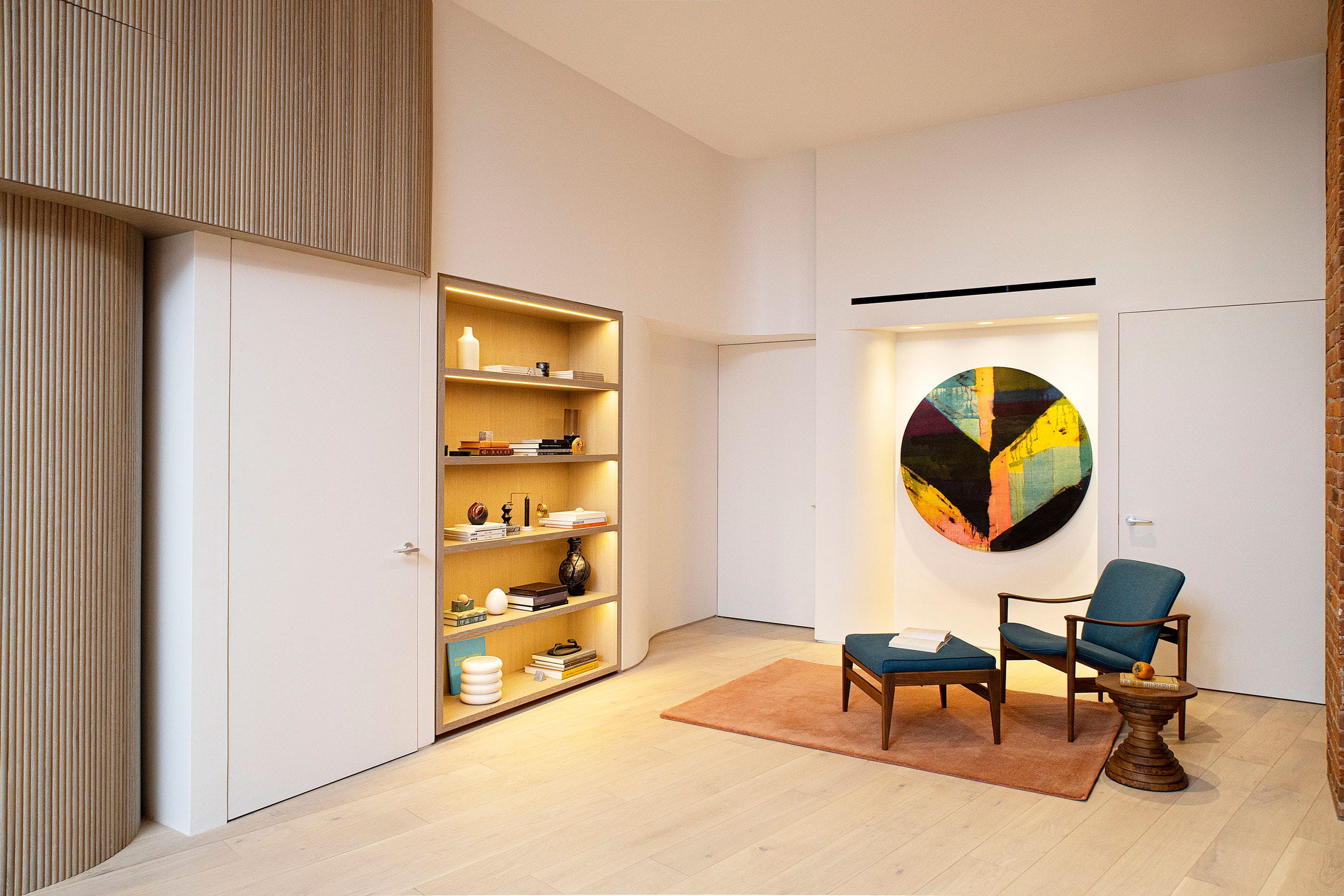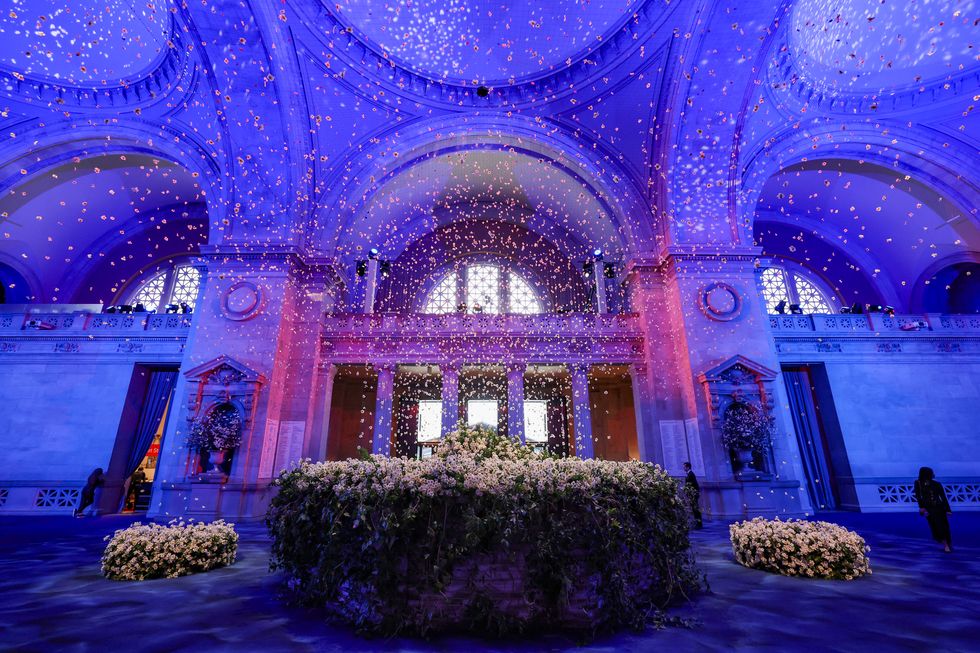Longchamp’s American flagship—a two-story building on the corner of Spring and Greene in SoHo—doesn’t beg for attention. Built in 1950, its classic brick exterior blends into the streetscape with quiet ease. That is, until your eyes land on the towering, 42-foot-high wall adjoining the store’s facade. Now drenched in the brand’s signature “energy green,” it offers an unmistakable hint that the French heritage brand has been shaking things up.
Inside, the transformation is unapologetically dramatic. Polished, ribbon-like forms of 110,000-pound hot-rolled steel ripple through the space in sculptural waves, appearing to unfurl from the ceiling itself. Upon each, the brand’s iconic bags take center stage. Grounding it all is a vivid circular carpet with a rippling motif echoing the flowing forms above. But the true invitation awaits just beyond the entrance: a dramatic staircase, boldly clad in can’t-miss neon green, rising against a sleek glass balustrade that leads to a second floor where the carpeting continues. Here, walking away with a new bag is only half the point.
In a time when shopping is just a tap away, Longchamp—family-owned since 1948—is proving that brick-and-mortar is still relevant, and can even surprise us. The brand tapped designer Thomas Heatherwick of Heatherwick Studio to reimagine its SoHo flagship. Heatherwick, alongside Neil Hubbard, a partner at the firm, first remodeled the 9,000-square-foot space in 2006, rescuing it from what Architectural Review called “a bad ‘80s makeover.” Now, nearly two decades later, they were ready to take on the challenge again.
“If we want to exist as a brand, we must be bold and to do things that are remarkable,” Longchamp CEO Jean Cassegrain tells ELLE Decor. “Our business in the US in the past two years has been extremely strong. Knowing customers support us with their wallets gives us confidence to push things further and create some excitement.”
Renowned for redefining architecture through immersive, sculptural design, Thomas Heatherwick has earned global acclaim for transforming spaces into emotional experiences. His London-based studio is behind famous works like the honeycomb-like Vessel in New York, London’s futuristic Rolling Bridge, and the Seed Cathedral at the Shanghai Expo. Blending architecture, art, and engineering, Heatherwick prioritizes emotional impact as much as function—an approach his team brought to Longchamp.
Updating “La Maison Unique,” as the brand first dubbed the building, meant balancing respect for its heritage with a bold new energy. “We wanted to draw attention without overwhelming the facade,” says Hubbard. “So we looked for subtle ways to enhance visibility—awnings, steps, facade details.” They also teamed up with local neon manufacturers to create vibrant window animations that energize the exterior without overpowering its understated charm.
The interiors were another story. The team agreed that the staircase is the defining moment of the space—and reimagining it required deep reflection. “It is both a beautiful piece of geometry and an explorable space,” Hubbard says, recalling the intense design process when it was first built. “We must have gone through 50 balustrade designs, if not more. It was such a painful process.” Originally finished in an oak hue, the staircase was given a burst of fresh energy in a vibrant neon green. “The store has minimal street-level presence, so the stairs become this landscape you ascend,” he explains. “It invites you even more so now.”
Another bold gesture comes in the form of vibrant green rugs that cascade down the center of each column on the second floor like spilled matcha. But bringing that vision to life proved challenging. “We imagined this rug pouring down the column and loved it, and we asked ourselves, ‘Okay, how are we actually going to do this? Do rugs even bend?’” he recalls. The team went through multiple prototypes to achieve the right three-dimensional effect and seamless stitching. The finished rugs ripple at the edges, adding a playful, fluid energy to the space. “It feels almost effortless—but, in truth, there’s a whole lot of effort behind it,” Hubbard says.
The layout across both floors—and out onto the terrace—is a study in curves over corners, fostering a sense of continuity. Mid-century design cues punctuate the space, from sculptural lamps to the iconic Croissant Sofa by Raphael Raffel. On the ground floor, much of the merchandise has been pared back to make room for artistic installations and cozy conversation areas that encourage that residential, lived-in feel. “Think of a real Parisian apartment—rarely are two pieces of furniture identical,” Hubbard explains. “It’s collected, eclectic, and tells a story. That was our inspiration.”
That layered, inclusive spirit echoes Longchamp’s own design philosophy—where there’s a bag for every type of person. “All generations will find comfort here,” says Sophie Delafontaine, Longchamp’s creative director. “The student, the mother, the grandmother, and the father. Everyone can find something that is going to resonate for them in this space.”
Ultimately, the project affirmed the resilience of the team’s original vision. “What we designed 20 years ago was very architectural, so we could strip it back to its essence and start fresh if we wanted,” Hubbard reflects. “But instead of wiping the slate clean, we carefully considered what to carry forward, what to reuse, and how the new elements could stand the test of time.”
Rachel Silva is the associate digital editor at ELLE DECOR, where she covers all things design, architecture, and lifestyle. She also oversees the publication’s feature article coverage, and is, at any moment, knee-deep in an investigation on everything from the best spa gifts to the best faux florals on the internet right now. She has more than 16 years of experience in editorial, working as a photo assignment editor at Time and acting as the president of Women in Media in NYC. She went to Columbia Journalism School, and her work has been nominated for awards from ASME, the Society of Publication Designers, and World Press Photo.







